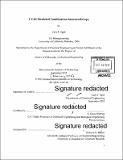T cell mediated combination immunotherapy
Author(s)
Opel, Cary F. (Cary Francis)
DownloadFull printable version (25.86Mb)
Other Contributors
Massachusetts Institute of Technology. Department of Chemical Engineering.
Advisor
K. Dane Wittrup.
Terms of use
Metadata
Show full item recordAbstract
Immunotherapy is a broad treatment strategy that harnesses the immune system to fight off a particular condition or disease. Cancer immunotherapy is the specific application of agents designed to interact or stimulate the immune system to fight off tumors. Treatments as diverse as passive antibody therapy, cytokine support, and comprehensive adoptive T cell transfer make up the broad field of immunotherapeutics. Due to the naturally complex interactions inherent in the immune system, there are many options for therapeutic intervention, however, this same complexity makes it extremely difficult to optimize treatment strategies. Because of this, research into developing new immunotherapies, optimizing existing immunotherapies, and designing new combinations of immunotherapies is still critical in the fight against cancer. Although there have been ongoing successes of individual immunotherapies in the clinic, the complexity and interdependence of the immune system suggests that any single therapeutic intervention will be insufficient to reject established malignancies. Increased interest in applying combinations of immunotherapies in the clinic requires more thorough preclinical work to guide the designs of these studies. The work presented in this thesis focuses on developing combinations of immunotherapies to treat preclinical models of cancer, as well as studying the underlying mechanism of tumor control. T cells are potent mediators of cytotoxicity and when properly used in adoptive cell transfer (ACT) protocols, can be highly effective in the treatment of cancer. ACT consists of three steps: 1) harvesting and purifying T cells from the patient, 2) enriching or modifying the T cells to become tumor specific, and 3) reinfusing the T cells along with supporting therapies. Therapies given alongside ACT are often adjuvants designed to enhance T cell response. However, focusing therapies only on enhancing the activity of the transferred T cells may miss out on synergistic effects when other parts of the immune system are simultaneously engaged. To study the effect of adjuvant therapy on ACT, a preclinical murine model was analyzed. Large, established B16F10 tumors were controlled when pmel-1 T cells were given with a course of supportive MSA-IL2 cytokine therapy, however, no cures were observed. When a course of TA99 antibody therapy was added alongside ACT, a high rate of cures was observed. Flow cytometry of both circulating and tumor infiltrating pmel-1 cells showed massive expansion and activation. Additionally, tumor infiltration of neutrophils, NK cells, and DCs were greatly enhanced by adjuvant therapy. DCs in the tumor draining lymph nodes were largely unchanged by the therapies. Engagement of the humoral immune response was also observed in both treatment cases. Surprisingly, antibody therapy did not substantially alter any of the mechanistic observations made in this study, despite its critical role in achieving cures of tumors. While ACT is a highly effective therapy, its clinical applicability is hindered by the complexity of performing T cell transplants and manipulations. A more optimal solution would involve purely injectable treatments that could elicit the same level of tumor specific T cell response in conjunction with potent recruitment of the adaptive immune system against tumors. To achieve this, working in collaboration with the Irvine Lab, combinations of immunotherapy using up to four different components were tested to identify critical factors in the successful rejection of established tumors in preclinical models. The four components of tumor targeting antibody, cytokine support, checkpoint blockade, and cancer vaccine acted synergistically to reject tumors from B16F10, TC-1, and DD-Her2/neu cell lines. The cancer vaccine elicited large numbers of tumor-specific T cells, and acted as a replacement for ACT. By analyzing subset combinations of this full treatment, the roles of each therapeutic component were identified. CD8 T cells and cross-presenting DCs were critical to curing subcutaneous tumors. Cytokine therapy was indispensable for effective tumor control, promoted immune cell infiltration into the tumor, and led to an increase in DCs. In combination with the other therapies, vaccination against a tumor antigen elicited a strong immunological memory response that was able to reject subsequent tumor rechallenge, as well as promote antigen spreading to new epitopes. Successful combinations were demonstrated to be dependent on the recruitment of both the adaptive and innate branches of the immune system. Finally, the efficacy of this combination of treatments was demonstrated by controlling the growth of induced tumors in a BRaf/Pten model. Combination immunotherapy promises a future where synergistic treatments are specifically tailored to individual cancers leading to highly effective responses. However, determining the optimal combination of therapies, the complexity of dosing strategies, and the availability of targeted treatments are all barriers that must be overcome. The analysis presented here will make a significant contribution to the body of knowledge on immunotherapy as it has shown the importance of combining orthogonal immunotherapies in order to get durable cures to established tumors. These results will hopefully encourage combinations of orthogonally acting therapies based on T cells to achieve stronger clinical responses. By determining the necessary requirements for a strong, synergistic response to tumorous growths, more effective combination immunotherapy protocols may be designed in the future.
Description
Thesis: Ph. D., Massachusetts Institute of Technology, Department of Chemical Engineering, February 2016. Cataloged from PDF version of thesis. "September 2015." Includes bibliographical references (pages 128-131).
Date issued
2016Department
Massachusetts Institute of Technology. Department of Chemical EngineeringPublisher
Massachusetts Institute of Technology
Keywords
Chemical Engineering.